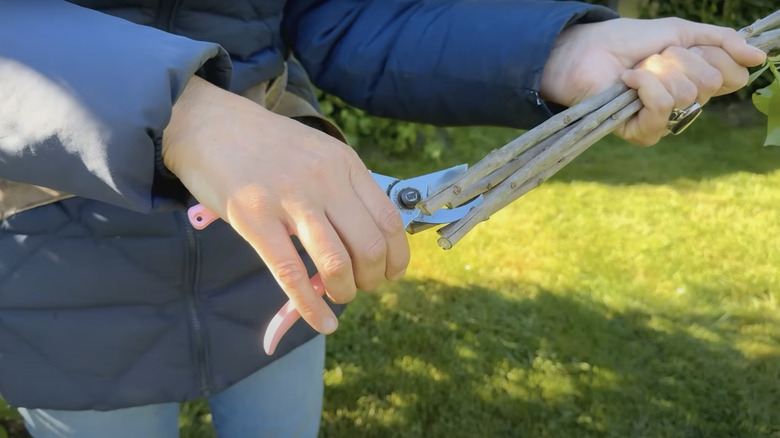The Simple Hack That Stops Lilacs From Dying In The Vase
We may receive a commission on purchases made from links.
Lilac shrubs have lots of benefits for a garden. They're a stunning flowering bush that will turn your garden into a bird paradise, their heavenly scent is a delight to the nostrils, and, of course, their blooms make for a fairy-tale centerpiece on your Mother's Day celebration table. Fresh-cut lilac flowers typically only last around five days in a vase, maybe a little longer if you take very good care of them. Extending that vase life, conversely, involves getting a little destructive with these beautiful blooms. Generally, you get five or six days of vase life from lilacs; to reach that six-day mark or even push a little past it, you need to smash the woody stems with a hammer to crush them before arranging them in a water-filled vase.
Lilac (Syringa vulgaris) and its cultivars are cold-climate plants prized for their fabulously fluffy yet fleeting blooms. They only appear for a short time in May each year, and don't last long in a vase. Why? The brown-copper stems are notoriously tough — or woody in horticultural speak. Cutting a stem of inflorescence from its parent shrub blocks the transport routes water once took to reach the blooms. The stem struggles to take up enough water to hydrate the flowers, no matter how much you fill the vase or how often you change the water, and the entire display quickly wilts. (Note that this isn't limited to just lilacs; it happens with other woody stemmed cut flowers, too — dogwood, eucalyptus, mimosa, and more.)
Crushing fresh cut lilac stems: a how-to
Before you can start planning all the gorgeous ways to incorporate lilac into your home decor, you need to make sure the vibrant blooms will last days, not hours, after picking. It's time to start crushing! Toolwise, you'll need a hammer, a rubber or iron mallet, or the back of your shears. You'll also need a sturdy surface to bang on, like a large rock or disused paver. Wear gardening gloves for safety. Have a bucket filled with fresh, cool water nearby. Strip all the leaves from your stem and lay the cut end of the stem on your hard surface. Pick up your smashing implement of choice and gently hammer the end of the stem until it just starts to break apart. You want to split the stem, not smoosh it into a sticky mess.
Once you've gently cracked the stems apart, grab a hold of the strands of bark and stem and pull them upwards, away from the cut end. This opens up the cracks and splits the stem more. Immediately place the crushed stem into your water-filled bucket to mitigate damage caused by exposure to the air and let it soak up all that life-giving hydration. A short, wide vase fitted with a flower frog or wire mesh shows off the blooms best. A 3.15-inch-wide Eggone Large Brass Floral Frog Flower with Rubber Base costs about $22. If the blooms are particularly droopy, fill a heat-proof jar with boiling water and plunge the stems into it before arranging them.
Another technique for keeping cut lilacs fresher longer
Not everyone agrees that crushing lilac stems is the best way to keep your cut flowers fresh longer. Smashing, some experts note, damages the plant tissues, creating wounds that allow plant health-harming bacteria to enter the stems, making them more prone to rotting and inhibiting water uptake once placed in a vase full of water. Conversely to the aims of the hammering technique, this reduces the amount of stem surface area available to suck up water and keep blooms erect. If you're unsure whether pounding the stems is a good idea, there's another method you can try: You can split the stems.
Grab a pair of shears or heavy-duty pruners, first making sure they're sharp and clean. Starting at the cut end of the stem, run an open blade upward a single time, creating a vertical slit somewhere between half an inch to 2 inches long. Then, pull one side of the slit upward and twist it back onto the stem. You can also shave the bark off the stem before slicing it vertically or cut the stem lengthwise at a dramatically extended angle. An alternative to a slit is to cross-hatch the stem about an inch up from the bottom. If you're having a hard time slicing through the stem, soak your lilac branches in fresh water for 20 minutes or so to soften them and make them easier to cut cleanly. You can even do all the cutting when the stems are submerged, preventing the air from filling and blocking the water-drinking vessels.

